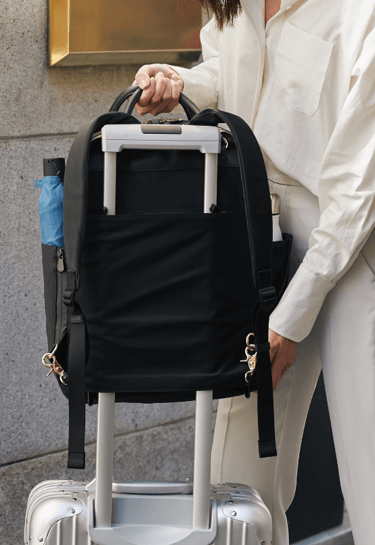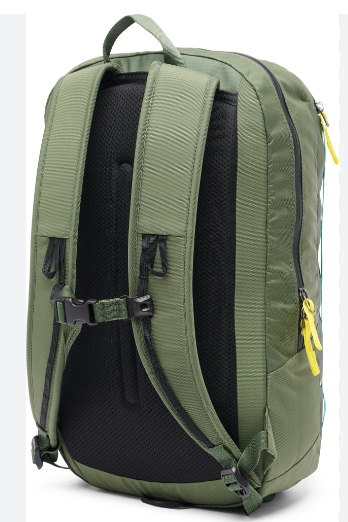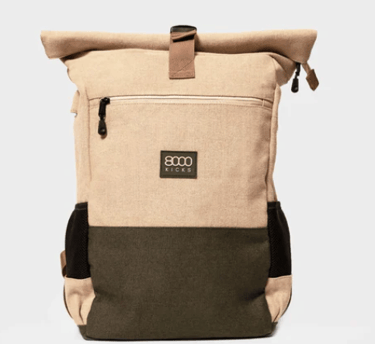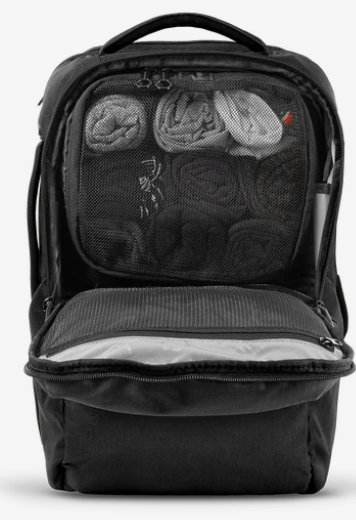Top 7 Sustainable Backpacks
Best sustainable backpacks for any events and travels
ACTIVE LIFESTYLE
Greenly World
11/3/2023
We've taken a look at best and most sustainable/eco friendly backpacks that are of high quality and functionability as well. Some are for daily use, such as school or work, while others for smaller/business trips, and backpacks for longer trips (weeks of travel).
All are great options depending on the type, style, and function of the backpack, see below for in depth info on these sustainable backpacks. Nb: Some have been removed from the list.
Quick Links:
8000 Kicks - Most innovative design and overall best for all occasions
Nr 2 - Versatile for all occasions (Travel, Work, School)
Nr 3 - Mostly ideal for women
Nr 4 - Best for longer travels and hiking (+ 2 weeks)
8000 Kicks (Sustainable Backpack)
Price Range $159
Materials Used
Crafted from durable, naturally water-resistant hemp fabric, makes nr1 a very original and sustainable brand!
Features
Expands from 18 to 30 liters, plenty of space for your gear
Laptop compartment fits up to 15 inches (38 cm), perfect for work or school
Hidden USB port keeps devices charged on the go
Nifty anti-theft pocket for valuables
Lasts for years due to the hemp fibres
Waterproof and dustproof, and easy to clean as well
Can fit perfect under the cabin when you travel
Choose between black or beige/green
Certifications
CITEVE,
Certified Bloom
OEKO-TEX,
Eco Stylist Certified
Sustainability
Hemp is renewable and carbon-sequestering
Factories powered by 40-50% renewable energy, with plans for more!
Offset all emissions through tree planting and farming hemp themselves
Vegan materials usually mean fewer carbon emissions than leather
Overall
For stylish sustainably-minded adventurers, these backpacks will serve you well on the trail, airplanes or in town. The durable hemp, the affordable priced backback and eco practices make them tops in our book.
Number 2 backpack
Price Ranges: $125-245
Priced accessibly at $125-245, these durable packs are affordable for life's journeys.
Materials Used
Shore-TexTM and Artemis fabrics crafted entirely from rescued ocean plastics
Shore-PlastTM encases boomboxes for musical mates
Features
Lifepack wows with solar charger, theft-proof lock and USB out
Bluetooth speaker jams wherever trails may roam
Backed a decade so you can really soak up sights
Comes in 3-5 different colors
Perfect for any kind of adventure
Water resistent bottom
Size inside: from ca. 18 L - 27 L
Three compartments with compression straps on the top/bestseller backpack
Waterproof in the bottom
Incl. many small specific type pockets (passports, sunglasses etc.)
Certifications
B Corp status necessitates suppliers undergo rigorous audits
Sustainability
Number 2 and partners has already removed an incredible 1.4 million pounds (635 029 kgs) of plastic from the oceans
Carbon balanced through 10 years of adventures ahead
Ocean plastic salvaging supports Philippines communities
Overall
For travellers treasuring Earth, nr 2 seamlessly synthesizes savvy style and function, conservation conscience. Journey on, Number 2's sustainable backpacks are super great for any kind of travelling, with stylish design and perfect for on the go travels. It is probably of the most practical travel friendly backpack in our opinion, and their customers agree as well!
Number 4's Travel Pack (Best for long travels)
Price Range: $55-$220
Number 4 backpacks offer travelers and commuters a sustainable yet stylish solution for everyday carrying needs.
Materials
Made with (Re)PurposeTM:
Features
Includes rain cover
Can be carried on most airlines, although it has space for 35 L
10 + other features
Spacious Design: The roomy main compartment provides enough space for carrying essential items while biking, daily commutes or week long trips
Fun Color Combos: Each bag features a one-of-a-kind color combination handpicked by the artisan who made it, adding a signature touch.
Certifications
Climate Neutral Certified: Number 4 is certified climate neutral, meaning they measure, reduce and offset their carbon emissions to be net zero.
Certified B Corporation
Sustainability
Certified B Corporation - Certified by the nonprofit B Lab to meet rigorous standards of social and environmental performance
Sustainable Materials - 94% of products currently contain repurposed, recycled, or sustainably sourced materials called "The Three Rs"
Carbon Neutral - Number 4 measures, reduces and offsets its carbon emissions to be certified carbon neutral
Supply Chain Standards - All factories must adhere to strict code of conduct verified by third-party audits
Product Donations - Provides backpacks and emergency kits to disaster relief efforts and refugee organizations
Product Longevity - Repair program and trade-in options aim to extend the lifespan of products
Overall
Overall, number 4 travel backpacks offer an eco-friendly and ethical option for bike commuters and travelers seeking a sustainable bag that also gives back. Their use of upcycled materials, certifications and supply chain transparency reflect nr 4's commitment to sustainability and social good. If you're a bike commuter or on a long trip for 1 -2 weeks, their number backpack is a very good choice to consider.
Number 3 Backpacks
Price ranges: $149–$658
Materials used
The bags are primarily made from recycled polyester derived from plastic bottles, with some containing up to 100% recycled content.
The Catalina collection uses a blend of recycled cotton canvas and organic canvas for a more sustainable option.
Vegetable-tanned leather accents are also used on some professional style bags.
Features
Luggage Integration: All backpacks feature a sleeve on the back to accommodate the handle of rolling luggage.
Modular Design: The packs offer different compartments and organizational features to suit different carrying needs.
Upcycled Collection: Number 3 hand makes zero waste laptop sleeves and patchwork totes from returned bags, keeping them out of landfills.
Can be used for work, gym, weekends and travel, making it highly versatily
Certifications
Number 3 products carry eco-friendly certifications including OEKO-TEX® Standard 100 for chemical free textiles and Bluesign® for sustainable material selection and processing.
Sustainability practices
• Material Sourcing - They use recycled polyester, organic cotton canvas and vegetable-tanned leather in their bags.
• Ethical Production - Their overseas factory is closely monitored and meets high standards for fair labor practices.
• Domestic Manufacturing - Some products are made in a small solar-powered workshop in the US.
• Renewable Energy - Solar panels power their production facilities to reduce carbon emissions.
• Water Management - Wastewater from production is treated and converted into drinking water.
• Product durability - Bags are repaired and resold through The Renewal Workshop to extend their lifespan.
• Charitable Giving - They regularly donate to environmental nonprofits and organizations that support public green spaces.
Overall
The number 3 collections offer sustainably made and ethically produced backpacks that are well suited for travelers, professionals and students looking for eco-friendly options. The use of recycled materials, certification to various sustainability standards and green practices throughout their supply chain reflect number 3f' commitment to reducing their environmental impact. While some backpcks have a higher price point, the focus on durability and the quality of their sustainable materials helps justify the cost.
Summary
Many great options to choose from, style of backpack, use of backpack (travel, work, school, weekends, etc), budget, sustainability practices they provide to make an easier choice.
Whichever one you choose you'll make sure to make a positive positive difference for yourself and the planet, by choosing a sustainable and eco friendly backpack.








FAQ - Sustainable Backpacks
Do sustainable backpacks reduce waste and are good for the environment?
Yes, for example recycled polyester, nylon, or other materials does reduce the impact on the environment, because the material is given a second life instead of being thrown out in landfills.
Are the backpacks biodegradable?
Sustainable backpacks are designed with biodegradable parts that are involved, which can decompose in nature.
Do sustainable backpacks have minimalist packaging?
These backpacks are made to only have the necessary parts, in order to design the backpacks. Therefore, there is not enough materials to make the backpacks, which reduces the environmental impacts. It's usually a more simplistic design that uses less materials to make a functional sustainable backpack.
Are sustainable backpacks durable?
Yes, they are made to last longer to reduce the need for buying new ones every year. It can resist normal wear and tear for longer than most conventional backpacks. They can last for many years with good and proper care.
What are some certifications to look for?
Some certifications to look for is the Fair Trade, B Corp, GOTS (Global Organic Textile Standard), among others. They show that a brand has a high standard for environmental and social norms, such as for ethical practices and sustainable manufacturing.
Which materials are usually used for sustainable backpacks?
Sustainable backpacks use recycled materials such as recycled nylon and polyester, and natural resources such as organic cotton, hemp, vegan leather and more.
The history of the Backpack
Modern backpacks have been around for over a century, however the timeline of the backpack goes back way beyond that. Looking at documented history, the first bag that we know of was made in 3300 BC. Otzi, which is the first natural mummy, had his possessions revealed, which indicated that people wore backpacks 5000 years ago, where he was buried in the glaciers of the Otztal Alps.
It was a group of German hikers who saw Otzi’s backpack back in 1991, but the modern backpack was designed many centuries later after 3300 BC.
The beginning of the modern backpack
The first move to the modern backpack was Henry Merriam, and he made his Knapsack. The knapsack was invented for use by the US Army. He used a metal frame, instead of shoulder straps. He believed that this design would free the soldier from the burden of straps and fasteners, but it was not a comfortable backpack.
Then later in 1908, a Norwegian inventor named Ole Bergan, wanted to design more comfortable backpack. He made a version that was patented for 25 years.
12 years later, a man named Lloyd Nelson wanted to redesign his pack after visiting Alaska. The wood and sealskin packs used by indigenous people, provided the information he needed. So he made a wood frame pack with canvas bands, and applied pins to attach a cloth bag, and it was called a ‘Trapper Pack’.
18 years later in 1938, Gerry Cunningham made the first backpack with zippered closures. There was only used buckles and straps. At the time, backpacks were only used for hiking, camping, and climbing. His zippered backpack was great and kept his stuff as light as possible, and easily accessible.
Then a decade later in 1950, Åke Nordin who is the founder of Fjällräven, used his mother’s sewing machine to make a small canvas bag, which was close to his pack, and the soft pack was kept in place by leather straps fastened to a wood frame.
Lowe
In 1967, Greg Lowe made the first internal frame backpack. Lowe saw that external frame packs were not balanced for rough terrain. So he decided to make a pack flexible enough to support the user’s back, yet stiff enough to make the load. He then made side compression straps and a sternum strap.
The first to get credit for making the modern backpack
Dick Kelty is the one who is credited with making the first modern backpack in 1952. He was in the Navy, which impacted the design of his backpack. He was very outdoors and wanted to make a functional backpack. He used his technical skills to design the backpack, and his wife, Nena, made the stitching. She used material from the military, and wool carpeting for the shoulder straps. Then, the couple made a local shop where the would sell backpacks to anyone who wanted one.
The reason for backpack invention
Before the backpack it was challenging to transports belongings from one place to another. With the need for bags to be more convenient to carry, it then led to a modernized backpack design.
People who needed backpacks:
School children: Children had to carry not so comfortable book straps to school beforehand. Because carrying books was necessary, there was a need to have a functional backpack.
Work travelers: Traveling for work has always been common, perhaps not for farming, but in case it is common. People who traveled a lot for work, needed a backpack that was comfortable and durable.
Hikers and Campers: Unlike people who traveled for work, these people were doing this in their spare time. They had specific equipment to make a home in the new discovered location, and they needed a sturdy backpack for the camping tools and supplies. You need to carry bottles, clothes, and therefore the need for having a good backpack was necessary.
There are two types of backpacks; outdoor and academic backpacks. The outdoor backpacks are for recreational activities, and the academics are for students and learners to be used for their educational purposes.
JanSport made their own nylon lightpack, based on Gerry Cunningham’s design prior to that. The backpacks were sold to hikers, but students were starting to use them to carry their books around campus. The trend caught on and companies started to make backpacks for students as well.
Sources:
Terra Thread
History of the Backpack | Buffalo Jackson
Contacts
greenlyworld@hotmail.com
